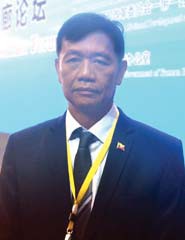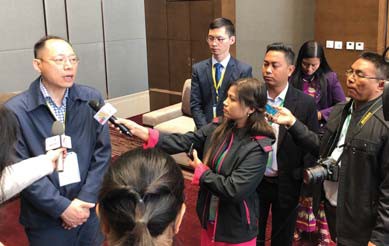28 February
One of the main topics discussed at the recent China-Myanmar Economic Corridor Forum was constructing a railway linking between Yunnan Province in southwest China and Mandalay. The following are excerpts of interviews with participants of the forum related to this topic.
Mr Xie Guo Xiang (Economic and Commercial Counsellor of the Chinese Embassy in Myanmar)
Q: Could you tell us a summary of the ongoing economic cooperation negotiations carried out at the China-Myanmar border?
A: Border trade is an important project for China. We value it. That is why we are working closely with Myanmar to implement the economic zone there. The first category to carry out is the constructing the Muse-Shwe Li railway.
It’s a large-scale project with many relevant departments from both China and Myanmar involved in it. It’s not something we can accomplish immediately. By bringing the relevant departments from both countries to the economic corridor forum for discussion, it’s a lot easier to work on cooperation as we can openly exchange our opinions. Plus, the Chinese embassy in Myanmar will also strive to accomplish this project.
Q: The success of the China-Myanmar Economic Corridor will be determined by the results of this forum. As such, to what degree did you achieve success in the forum’s discussions?
A: This is the second meeting for the joint-committee on the economic corridor and the second forum as well, and we have seen numerous accomplishments on both fronts. We were able to get into deep discussions on the important project that both sides are concerned about. Myanmar will also list the Kyaukpyu Special Economic Zone (SEZ) project and the China-Myanmar railway project under the economic corridor’s processes for implementation.
These two projects will be given top priority because they are certain to improve the socioeconomic livelihood of both countries’ inhabitants. Not only that, I believe they will also provide substantial support to the entire economic development of Myanmar. China will be pushing forward the companies on its side responsible for the two projects. In addition, we will also be trying for good results at the second Belt and Road Initiative forum in April.
Q: Were there any difficulties discussing some topics and did you agree on anything?
A: There weren’t any difficulties as both sides were keen on holding discussions in an open manner. I believe there won’t be any difficulties in future discussions either.
Q: How will the Chinese government manage its investments?
A: China will put into consideration Myanmar’s budget constraints. We will put the majority of our investment in these projects.
Q: How will the benefits from the projects be distributed when they succeed?
A: The projects are cooperation between China and Myanmar but the main players are the companies. This means we need to take our approach from a market economy perspective. We must also proceed with trade in line with set policies. When the projects succeed, the relevant organizations from both sides will receive their share of the benefits as outlined in the contract we will be signing. The companies will be receiving their share if profits are made but will also be accountable for losses incurred. Benefits will be distributed in accordance with contracts signed between the companies and the government. They will also have to bear taxes.
Q: Could you give us some comments on the forum?
A: China and Myanmar both wish to elucidate the economic corridor and that is why we have held the joint-committee meeting and economic corridor forum twice within six months. There have been various successes. I believe that once we put the projects into action there will be beneficial effects for both the two countries’ economies and the people’s socioeconomic livelihoods.

U Aung Win (General Manager, Myanma Railways)
Q: Could you tell us how the China-Myanmar railway is being carried out?
A: The Muse-Mandalay railway project is an integral component for the economic corridor. It will be built from scratch. We signed an MoU on 22 October 2018 to carry out a feasibility survey for the project. We formed working groups in December of the same year and began our procedures. The main thing we had to do was survey the terrain between Mandalay and Muse.
Q: How are the investments organized?
A: The investments can come in any form. First, we need to reassess if this is viable from a business perspective. We need to see how much development there is in the railway’s vicinity. Then we need to consult the results before making any decisions. This project will be paving a new railway through the land so we need to evaluate to what degree the people along the trajectory will lose their land. Profits and benefits will be calculated much later. After all that, we will decide whether we will take a Government-to-Government route, or PPP, or acquiring a government loan.
Q: How will the results of the project be shared?
A: Like I said before, it depends on which direction we will be taking. If we take the PPP route then Myanma Railways – MR will be sharing duties and benefits with another company. If we take the G2G route then MR will be spearheading the project based on a loan. This project will be costing billions, so we need to make careful, well-informed decisions.
Q: Which company will MR be partnering with?
A: Currently, China Railway Group Limited (CREC) is conducting the surveys and is bearing the costs for that as well. Once we get to the construction phase, we will be calling an open tender and the winning company will be responsible for the construction.
Q: Do you have any plans to resolve complications that may arise during the project’s implementation?
A: The project is starting a new venture so there are bound to be numerous challenges. The biggest issue could be handling compensation for the local residents along the projected route of the railway. Also, about 155 kilometres of the entire 431 km-railway route will be passing through tunnels and we will be needing technological assistance from China. Both sides will need to cooperate closely on this.
Q: Do you have any opinions or comments regarding the project?
A: This Muse-Mandalay railway project is important for all of Myanmar. The main objective of the project is to facilitate faster supply chain transportation between Mandalay and Muse. About 40 per cent of our agricultural products are shipped to China. It will also improve passenger transportation and products from across Myanmar can be exported directly from Mandalay.
Q: Is there an estimated time period for the project?
A: It will take anywhere from 3 to 5 years to complete. We can only make a close estimate after we get the results from the survey and finalize designs.
Q: How will this project be explained to the public?
A: The project is still in its early phases. We’re initially collecting comments from relevant ministry departments. We’re also requesting feedback from state and regional governments. Officials will also be meeting with the local residents during the survey to carefully explain to them about the project. We will explain everything in detail to the public when we have a finalized report from the surveys.
BY Aung Kyaw Kyaw, Myint Myint Cho
(Translated by Pen Dali)



